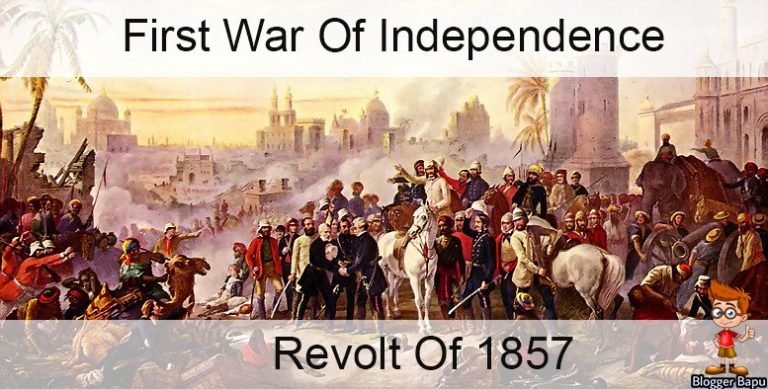The First Battle Of Independence – Revolt Of 1857:
By the main portion of the nineteenth century, the East India Company had brought real bits of India under its control.
One hundred years after the Battle of Plassey, outrage against the out of line and onerous British Government appeared as a revolt that shook the plain establishments of British administer in India.
While British students of history called it the Sepoy Mutiny, Indian antiquarians named it the Revolt of 1857 or the First War of Indian Independence. The Revolt of 1857 had been gone before by a progression of unsettling influences in various parts of the nation from the late eighteenth century onwards.

The Sanyasi Rebellion in North Bengal and the Chunar resistance in Bihar and Bengal broke out in the late eighteenth century. There were a few laborer uprisings in the mid-nineteenth century, the most essential of which were those by the Moplah workers of the Malabar and the Faraizi development by Muslim workers in Bengal.
The main portion of the nineteenth century additionally saw various ancestral revolts. In this unique situation, specify might be made of the uprisings of the Bhils of Madhya Pradesh, the Santhals of Bihar and the Gonds and Khonds of Orissa. Notwithstanding, every one of these unsettling influences were limited. Albeit genuine and, at times, long drawn, these did not represent any genuine danger to the presence of the British Empire.
The Revolt of 1857:
The primary articulation of sorted out obstruction was the Revolt of 1857. It started as a revolt of the sepoys of the Company’s army however in the end secured the interest of the majority. Its causes lay profoundly inserted in the grievances that all areas of Indian culture supported against the British run the show.
Causes of the Revolt:
Political Causes:
The political causes of the revolt might be followed to the British arrangement of development through the Doctrine of Lapse and direct addition. An expansive number of Indian rulers and boss were ousted, along these lines exciting apprehension in the brains of other decision families who captured a comparative destiny.
Also read this : Battle of the Catalaunian Plains | Battle of Chalons 20 June
Rani Lakshmi Bai’s embraced child was not allowed to sit on the position of royalty of Jhansi. Satara, Nagpur and Jhansi were added under the Doctrine of Lapse. Jaitpur, Sambalpur and Udaipur were additionally attached. Different rulers expected that the extension of their states was just a short time. The refusal to proceed with the benefits of Nana Saheb, the embraced child of Baji Rao II, made antagonistic vibe among the decision class.
In addition, the conclusions of the general population were harmed when it was pronounced that the relatives of the main Mughal Emperor, Bahadur Shah II, would not be permitted to live in the Red Fort. The addition of Awadh by Lord Dalhousie on the guise of maladministration left thousands of nobles, authorities, retainers and officers jobless. This measure changed over Awadh, a faithful state, into a hotbed of discontent and interest.
Social and Religious Causes:
An expansive area of the populace was frightened by the quick spread of Western human progress in India. An Act in 1850 changed the Hindu law of legacy empowering a Hindu who had changed over into Christianity to acquire his hereditary properties. In addition, the ministers were permitted to make transformations to Christianity all finished India. The general population were persuaded that the Government was wanting to change over Indians to Christianity.

The annulment of practices like sati and female child murder, and the enactment sanctioning dowager remarriage, were dangers to the set up social structure.Even the presentation of the railroads and broadcast was seen with doubt.
Financial Causes:
In country zones, workers and zamindars disliked the overwhelming duties on land and the stringent techniques for income gathering took after by the Company. Numerous among these gatherings were not able meet the overwhelming income demands and reimburse their advances to cash loan specialists, in the long run losing the lands that they had held for ages. Expansive quantities of sepoys were drawn from the working class and had family ties in towns, so the grievances of the laborers additionally influenced them.
The monetary misuse by the British and the total obliteration of the conventional financial structure caused broad hatred among all segments of the general population. After the Industrial Revolution in England, there was an inundation of British made merchandise into India which demolished ventures, especially the material business, of India.
Indian handicraft ventures needed to contend with shoddy machine-made merchandise from Britain. India was changed into a provider of crude materials and a customer of products fabricated in Britain. Each one of those individuals who beforehand relied upon regal support for their occupations were rendered jobless. So they bore a profound situated grievance against the British.
Military Causes:
The Revolt of 1857 began as a sepoy rebellion. It was just later on that different components of society joined the revolt.
Indian sepoys framed over 87% of British troops in India. They were viewed as mediocre compared to British troopers. An Indian sepoy was paid not as much as an European sepoy of a similar rank. Moreover, an Indian sepoy couldn’t ascend to a rank higher than that of a Subedar
The augmentation of the British Empire in India had unfavorably influenced the administration states of Indian sepoys. They were required to serve in regions far from their homes. In 1856 Lord Canning issued the General Services Enlistment Act which required that the sepoys must be prepared to serve even in British land over the ocean.
The ‘Bengal Army‘ was selected from high standing networks in Awadh. They were not set up to cross the sea (Kalapani) which was prohibited according to Hindu religious convictions. They built up the doubt that the Government was endeavoring to change over Indians to Christianity.After the addition of Awadh the Nawab’s army was disbanded. These troopers lost their methods for work. They turned out to be intense foes of the British.
Quick Cause:
The Revolt of 1857 in the long run broke out finished the episode of lubed cartridges. Talk spread that the cartridges of the new Enfield rifles were lubed with the fat of bovines and pigs. Before stacking these rifles the sepoys needed to gnaw off the paper on the cartridges. Both Hindu and Muslim sepoys declined to utilize them. Canning attempted to present appropriate reparations in light of the blunder and the culpable cartridges were pulled back, yet by then the harm had been finished. There was distress in a few spots.
In March 1857, Mangal Pandey, a sepoy in Barrackpore, had declined to utilize the cartridge and assaulted his senior officers. He was hanged to death on eighth April. On ninth May, 85 officers in Meerut declined to utilize the new rifle and were condemned to ten years’ detainment.
Headliners of the revolt:
Before long there was a resistance in the Meerut Cantonment. The Meerut Mutiny (May 9, 1857) denoted the start of the Revolt of 1857. The Indian sepoys in Meerut killed their British officers and tore open the correctional facility. On May 10, they walked to Delhi.
Catch of Delhi:
In Delhi the rebels were joined by the Delhi sepoys and the city went under their control. Following day, on eleventh May, the sepoys announced the maturing Bahadur Shah Zafar the Emperor of Hindustan. In any case, Bahadur Shah was old and he couldn’t give capable administration to the sepoys. The control of Delhi was brief.

Fall of Delhi:
The British at long last assaulted Delhi in September. For six days there was frantic fighting. Be that as it may, by September 1857, the British reoccupied Delhi. Thousands of pure individuals were slaughtered and hundreds were hanged. The old ruler was caught and later ousted to Rangoon where he passed on in 1862. His children were shot dead. Therefore finished the magnificent administration of the Mughals.
Focuses of the revolt:
The revolt spread over the whole territory from the area of Patna to the outskirts of Rajasthan. There were six primary focuses of revolt in these districts to be specific Kanpur, Lucknow, Bareilly, Jhansi, Gwalior and Arrah in Bihar.
Lucknow:
Lucknow was the capital of Awadh. There the mutinous sepoys were joined by the disbanded warriors from the old Awadh army. Begum Hazrat Mahal, one of the begums of the ex-ruler of Awadh, took up the administration of the revolt. At long last the British powers caught Lucknow. The ruler got away to Nepal.
Kanpur:
In Kanpur the revolt was driven by Nana Saheb, the embraced child of Peshwa Baji Rao II. He joined the revolt basically in light of the fact that he was denied of his benefits by the British. He caught Kanpur and declared himself the Peshwa. The triumph was brief.
Kanpur was recovered by the British after crisp fortifications arrived. The revolt was smothered with awful retaliation. The dissidents were either hanged or passed up standards. Nana Saheb got away. However, his splendid commander Tantia Tope proceeded with the battle. Tantia Tope was at long last crushed, captured and hanged.
Jhansi:
In Jhansi, the twenty-two-year-old Rani Lakshmi Bai drove the agitators when the British declined to acknowledge the claim of her received child to the position of royalty of Jhansi. She battled bravely against the British powers. Yet, she was at last crushed by the English.
Rani Lakshmi Bai got away. Later on, the Rani was joined by Tantia Tope and together they walked to Gwalior and caught it. Sindhia, a reliable partner of the British, was driven out. Wild fighting took after. The Rani of Jhansi battled like a tigress. She kicked the bucket, fighting to the specific end. Gwalior was recovered by the British.
Bihar:
In Bihar the revolt was driven by Kunwar Singh.
Concealment of the Revolt:
The Revolt of 1857 went on for over multi year. It was smothered by the center of 1858. On July 8, 1858, fourteen months after the episode at Meerut, peace was at last broadcasted by Canning.
Causes of the disappointment of the revolt:
Constrained Uprising:
Despite the fact that the revolt was genuinely far reaching, a substantial piece of the nation stayed unaffected by it. The revolt was primarily limited to the Doab district. Sind, Rajputana, Kashmir, most parts of Punjab. The southern regions did not participate in it. It neglected to have the character of an all-India struggle.Important rulers like Sindhia, Holkar, Rana of Jodhpur and others didn’t bolster the revolutionaries.
No Effective Leaders:
The radicals did not have a viable pioneer. Nana Saheb, Tantia Tope and Rani Lakshmi Bai were overcome pioneers, no uncertainty, yet they couldn’t offer viable authority to the development overall.
Restricted Resources:
The revolutionaries needed assets as far as men and cash. The English, then again, got a consistent supply of men, cash and arms in India.
No Participation of the Middle Class:
The English taught working class, the rich dealers, brokers and zamindars of Bengal helped the British to stifle the revolt.
Consequences of the revolt:
The colossal uprising of 1857 was a critical landmark in the historical backdrop of present day India. The revolt denoted the finish of the East India Company’s lead in India. India currently went under the immediate control of the British Crown. This was declared by Lord Canning at a Durbar in Allahabad in aproclamation issued on 1 November 1858 for the sake of the Queen. In this manner, Indian organization was assumed control by Queen Victoria, which, as a result, implied the British Parliament. The Governor General’s office was supplanted by that of the Viceroy.
The Doctrine of Lapse was nullified. The privilege to receive children as lawful beneficiaries was acknowledged. The Revolt of 1857 made ready for the future battle for flexibility in India.
Tags:
Revolt of 1857, First War Of Independence, Causes by revolt of 1857, Consequences of 1857 revolt, Sanyasi Rebellion, Nana Sahib, Tantia Tope, Rani Lakshmi Bai, Rani Laxmi Bai, Bengal Army




